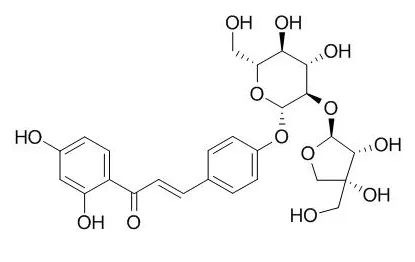| In vitro: |
| Toxicol In Vitro. 2009 Jun;23(4):680-6. | | Evaluation of antigenotoxic activity of isoliquiritin apioside from Glycyrrhiza glabra L.[Pubmed: 19490840] | Prevention of manifestation of events characteristic of carcinogenesis is being emphasized a rational strategy to combat cancer. Reactive oxygen species (ROS) play an important role in tumor initiation through oxidative damage of DNA.
METHODS AND RESULTS:
In search for lead molecules in cancer chemoprevention from natural products, a fraction 'Rlicca' isolated from Glycyrrhiza glabra was studied for modulatory effect against hydrogen peroxide and 4-nitroquinoline-N-oxide induced genotoxicity in Escherichiacoli PQ37 using SOS chromotest and in human peripheral blood lymphocytes using the Comet assay. The fraction 'Rlicca' at a concentration of 191 microM decreased the SOS inducing potency (SOSIP) of hydrogen peroxide (1.0mM) and NQO (20 microg/ml) by 83.72% and 68.77%, respectively. In the human blood lymphocytes, 'Rlicca' reduced the tail moment induced by hydrogen peroxide (25 microM) and NQO (5 microg/ml) by 88.04% and 76.64%, respectively, using the Comet assay. The spectroscopic data of 'Rlicca' fraction revealed it to be Isoliquiritin apioside, a chalcone oligoglycoside.
CONCLUSIONS:
This is the first report of Isoliquiritin apioside with marked potential to combat oxidative stress-induced genotoxicity. | | Front Pharmacol . 2018 Dec 10;9:1455. | | Isoliquiritin Apioside Suppresses in vitro Invasiveness and Angiogenesis of Cancer Cells and Endothelial Cells[Pubmed: 30618749] | | Abstract
Several components isolated from Glycyrrhizae radix rhizome (GR), including glycyrrhizin, liquiritin, and liquiritigenin, have been shown to induce cancer cell death and inhibit cancer metastasis. Isoliquiritin apioside (ISLA), a component isolated from GR, has been effective for treating tetanic contraction and genotoxicity. However, the effects of ISLA on the metastasis and angiogenesis of malignant cancer cells and endothelial cells (ECs) have not been reported. In this study, we found that up to 100 μM ISLA did not affect cell proliferation but efficiently suppressed the metastatic ability of HT1080 cells, as assessed by scratch-wound migration, Transwell® migration, scratch-wound invasion, Transwell® invasion, and three-dimensional spheroid invasion. ISLA significantly decreased phorbol 12-myristate 13-acetate (PMA)-induced increases in matrix metalloproteinase (MMP) activities and suppressed PMA-induced activation of mitogen-activated protein kinase as well as NF-κB, which are involved in cancer metastasis. In addition, ILSA treatment reduced the production of pro-angiogenic factors in HT1080 cells, including MMP-9, placental growth factor, and vascular endothelial growth factor under normoxia as well as hypoxia conditions, by impairing the hypoxia-inducible factor-1α pathway. We also found that the abilities of human umbilical vein ECs to migrate across the Transwell® and to form tube-like structures were significantly reduced by ISLA treatment. Moreover, using the chorioallantoic membrane assay, vessel formation with or without vascular endothelial growth factor was significantly suppressed by ISLA. These results suggested that ISLA possesses anti-metastatic and anti-angiogenic abilities in malignant cancer cells and ECs, with no cytotoxicity. ISLA may therefore be a safe and effective lead compound to develop anti-cancer drug for limiting the spread of primary tumors to distant organs to form secondary tumors.
Keywords: HIF-1α; HT1080; MAPK; NF-κB; angiogenesis; cancer; Isoliquiritin apioside; metastasis. |
|






 Cell. 2018 Jan 11;172(1-2):249-261.e12. doi: 10.1016/j.cell.2017.12.019.IF=36.216(2019)
Cell. 2018 Jan 11;172(1-2):249-261.e12. doi: 10.1016/j.cell.2017.12.019.IF=36.216(2019) Cell Metab. 2020 Mar 3;31(3):534-548.e5. doi: 10.1016/j.cmet.2020.01.002.IF=22.415(2019)
Cell Metab. 2020 Mar 3;31(3):534-548.e5. doi: 10.1016/j.cmet.2020.01.002.IF=22.415(2019) Mol Cell. 2017 Nov 16;68(4):673-685.e6. doi: 10.1016/j.molcel.2017.10.022.IF=14.548(2019)
Mol Cell. 2017 Nov 16;68(4):673-685.e6. doi: 10.1016/j.molcel.2017.10.022.IF=14.548(2019)